FREE Education
SUPPORTING FAMILIES THROUGH CHILDHOOD CANCER
What educational support is available for children and young people with cancer? Why is collaboration and communication so important?
EDUCATION WHILE ON TREATMENT
RETURNING TO SCHOOL


Family story
Charlotte Bowling, mum to Amelie, tells us about the innovative learning support her daughter and family received from her school Page 6
BACK TO BASICS:
Education after a childhood cancer diagnosis
What to expect from hospital teaching, ongoing education support and transitioning back to school Page 8
A FRESH START
Ruby Abramow, who was first diagnosed with a rare head and neck cancer aged nine before relapsing five years later, tells us how a new, supportive environment helped her thrive Page 14
MAGAZINE SUMMER 2024 | ISSUE 103
contact
INSIDE THIS ISSUE... ON EDUCATION
Summer 2024
05 Lydia Quine, a Young Lives vs Cancer social worker, tells us how she helps young people with cancer to continue their studies
10 Louise Robinson, a neuro-oncology outreach nurse specialist, emphasises the importance of collaboration to helping young brain tumour patients' education
11 Sophie Barclay, diagnosed with a brain tumour aged 15, tells us how, with the support of her school, she has received a conditional offer for university
12 Naomi Duxbury, whose daughter, Mia, was diagnosed with leukaemia aged four, tells us how she worked closely with her school to create a 'normal' and safe learning environment
16 Patient story
Lily Morris, who was 15 years old when diagnosed with leukaemia, describes the impact this had on her GCSE preparations and the support she received from her school
17 Delivering packaged drugs into paediatric brain tumours using ultrasound
A research project funded by The Little Princess Trust in partnership with CCLG
Contact
is a free, quarterly magazine for families of children and young people with cancer.
Contact aims to reduce the sense of isolation many families feel following a diagnosis of childhood cancer.
Children’s Cancer and Leukaemia Group brings together childhood cancer professionals to ensure all children receive the best possible treatment and care. Contact magazine was founded by The Lisa Thaxter Trust and CCLG and first published in 1999.
The contents of Contact are the copyright of the publishers. Articles may be reprinted without charge provided that credit is given to Contact magazine. A copy of any reprinted article should be sent to the editor at the address above. Please let us know your thoughts and feedback about Contact by emailing our Editor at editor@cclg.org.uk
Editorial Team and Board:
Managing Editor – Ashley Ball-Gamble
Editor – Claire Shinfield
Assistant Editor – Sam Chambers
Graphic Designer – Georgina Payne
Medical Adviser – Dr Bob Phillips
Medical Adviser – Dr Ren Manias
Ceri Hogg – Nurse, Cardiff
Mike Francis – Parent and Survivor, York
Katherine Ince – Survivor, London
Dr Vikki Langford – Psychologist, Birmingham
Dr Rebecca Mulholland – Psychologist, Sheffield
Rachael Olley – Parent, CCPA
Gayle Routledge – Parent, Stafford
Samantha Schoolar – Survivor, Coventry
Gill Thaxter – Parent, Coulsdon
04 Medical adviser Dr Ren Manias introduces the theme of ‘Education'
04 News in brief
A round-up of the latest updates in childhood cancer
08 Back to basics
Keely McEvoy, Lead Assistant Headteacher of the Medical Needs Teaching Service at Leeds Children's Hospital, explains what to expect with education after a childhood cancer diagnosis
15 A parent's view
Lauren Bryce, whose son Alfie was diagnosed with cancer aged 15, writes about their struggles with the education system and what helped him prepare for his GCSEs
18 60 seconds with...
Gail Beaumont, teacher at Sheffield Children's Hospital, tells us about her role
19 Ask the expert
ON THE COVER EVERY ISSUE
Emily Varley, a school special educational needs and disabilities coordinator, explains what an education, health and care plan (EHCP) is
06 Charlotte Bowling, whose daughter, Amelie, was diagnosed with leukaemia aged six, describes the innovative support they received to help with education
14 Ruby Abramow, who was first diagnosed with a rare head and neck cancer aged nine before relapsing when she was 14, tells us how a fresh start enabled her to take back control of her education
Nicky Webb – Nurse, East Midlands
Sally Morrison – Nurse, Leeds
Past issues of Contact: The wide variety of articles published during the year in Contact adds up to a valuable and informative reference archive. If you would like any back issues, please contact the Editor. Details of key articles in previous editions are listed on our website.
Contact Letters, CCLG, Century House, 24 De Montfort Street, Leicester LE1 7GB
Editor: Claire Shinfield editor@cclg.org.uk
facebook.com/ChildrensCLG
x.com/CCLG_UK

instagram.com/CCLG_UK @CCLG_UK
KEEP IN TOUCH
www.cclg.org.uk Contact Magazine | Issue 103 | Summer 2024 2
From Contact's last edition:
Amelia’s story inspires and informs
“What an incredible young lady and a real inspiration to other children needing surgery.”
Praise for The Oncology Guide childhood cancer web resource
"What a wonderful resource. Well done."
Find out more about The Oncology Guide at www.theoncologyguide.co.uk



CCLG’s information resources supporting professionals and families
“I am a newly qualified paediatric nurse and am about to start a job in paediatric oncology. I find the publications really useful for my personal learning development and helping to be equipped when talking to patients and their parents.”
CCLG’s research webinars continue to provide insight
“Very interesting talk, and educational even to a long happily retired consultant paediatric radiologist.”
“I provide support to children and young people with cancer and it’s helpful for me to understand how cancer treatment affects children and research that is being done.”
"I wanted to gain an insight into the experience of young people with cancer, as it's not an area I know much about. A really good insight into some of the differences with the paediatric service, and some of the specific challenges young people might experience."
If you would like to SHARE YOUR STORY in Contact or have an idea for a theme for us to cover, please let us know. Email us at editor@cclg.org.uk
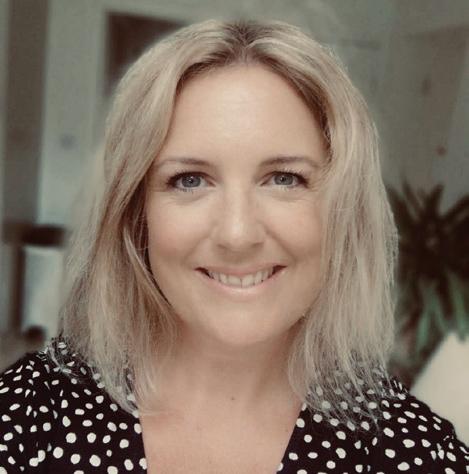
School and learning are part of normal life for all children and teenagers. A cancer diagnosis, however, can instantly disrupt this routine, impacting school attendance, friendships and learning. Thankfully, there’s now more support and awareness around education to help young patients keep up with their studies. In this issue, we hear a variety of stories from patients and families about their experiences of education and how schools have provided support by, amongst other things, offering phased returns, exam adjustments and keeping channels of communication open. We hope this edition can shine a light on what can help young pupils and their families following a cancer diagnosis.
Claire
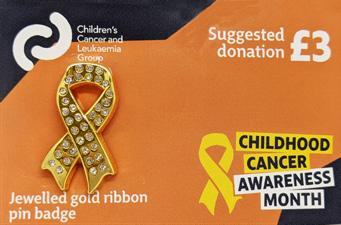

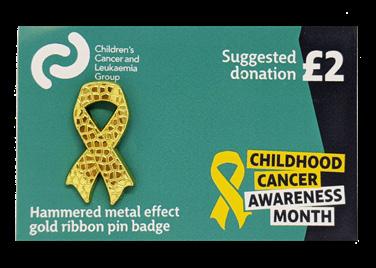


Order your gold ribbon (and other CCAM items) from our online shop.
Hello!
Your messages...
www.shop.cclg.org.uk
WEAR YOUR GOLD RIBBON WITH PRIDE THIS SEPTEMBER TO HELP RAISE AWARENESS AND VITAL FUNDS
Contact Magazine | Issue 103 | Summer 2024 3
NEWS IN BRIEF
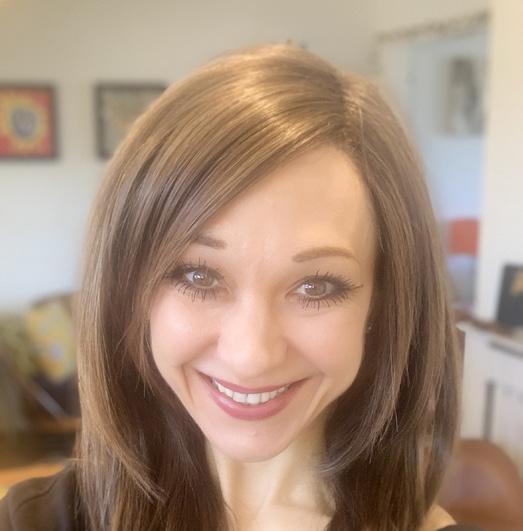
MEDICAL ADVISER
Dr Ren Manias
Consultant Paediatric Oncologist at Southampton General Hospital and CCLG member
Although a cancer diagnosis will inevitably have an impact on a child’s learning, there’s a lot of support available to help meet their educational needs during and after treatment. Attending school can improve children’s emotional wellbeing, reduce feelings of isolation and allow them to feel ‘normal’ by staying in touch with friends.
The ability to go to school varies depending on an individual child’s diagnosis and treatment. Some feel ready to return to school relatively quickly, but attendance is often sporadic and fluctuates throughout treatment. Schools are usually flexible, allowing a reduced timetable or half-days. Some children manage to return full time with the odd day off for treatment, whereas others are unable to return at all until treatment is complete.
If a child can’t attend their usual school, most children’s cancer centres have hospital schools. Hospital teachers can communicate with the normal school to ensure they cover relevant topics. There are also options for home tutoring, which are usually arranged through the regular school. Schools have become more accessible through remote learning opportunities since the COVID-19 pandemic, with some children accessing lessons online. It’s always worth talking to the school to explore these options. Remaining in regular contact with school can help ensure a child’s needs are met and facilitate a smooth, timely return when appropriate.
While going back to school can be scary for both parents and child, it's important for the child’s mental wellbeing. It helps with feelings of loneliness and provides a focus and an opportunity to improve social skills and build relationships with peers. It’s important to take part in PE, too, as exercise helps children regain strength and improves mental and physical health. However, tiredness and fatigue can be difficult, impacting concentration, mood and energy levels. This can last for a long time and needs to be managed carefully. Arranging a phased return to school can help, as can being flexible with expectations on attendance and workload.
If you feel your child’s needs aren’t being met, ask for help. Your treatment team is there to support and can advocate on your behalf.
Pioneering development aims to accelerate new childhood cancer treatments
Scientists and clinicians combining skills and experience in biology, multi-omics, advanced computing and artificial intelligence/machine learning are building the world's first ‘Virtual Child’ computer model of normal and cancerous human development at the level of each individual cell. The Virtual Child will ‘develop’ cancer and be put through unlimited virtual clinical trials that pinpoint, predict and prioritise potential new childhood cancer treatments. It will draw on billions of data points generated from millions of human and animal cells and will provide the world’s research community with a shared data and modelling environment that accelerates biological discovery, therapeutic invention and clinical trial research.
(Source: Cancer Discovery)
Critical period identified for young people’s mental health
A Canadian study has found that teenagers and young adults with cancer are more likely to be diagnosed with mental health issues than their siblings or peers. They looked at mood and anxiety disorders, substance use disorders and psychotic disorders. The study showed that patients were most often diagnosed with these problems within the first two years after diagnosis. This highlights the importance of good mental health and social support immediately after a cancer diagnosis.
(Source: Journal of Clinical Oncology)
Preventing reactions to chemotherapy
Dutch researchers have found that altering the way PEG-asparaginase chemotherapy is given could improve care. Hypersensitivity reactions can happen in PEG-asparaginase induction when there are breaks between doses. Patients' bodies develop antibodies that fight the drug, which stops it working properly. The study showed that giving the drug without any breaks could reduce the number of anti-drug antibodies and lower the chance of a reaction.
(Source: Journal of Clinical Oncology)
The Ellen MacArthur Cancer Trust has space on board
this summer
The Ellen MacArthur Cancer Trust has places on its free sailing and outdoor adventures this summer for any young people (aged 8-24) looking for post-treatment support. Its trips allow young people to meet others who have been through something similar and to rediscover what they're capable of after cancer. Find more information at www.bit.ly/EllenMcArthur
Contact Magazine | Issue 103 | Summer 2024 4
How do specialist social workers support young people with cancer during their education?
Education is a huge part of young people’s lives, but a cancer diagnosis can throw their plans completely off course. Lydia Quine, a Young Lives vs Cancer social worker, tells us how she helps young people with cancer to continue their studies and minimise the impact of cancer on their education.
Cancer not only affects people physically, but it can also have a huge impact on their social, emotional and educational wellbeing. This is particularly true for young people with cancer. The diagnosis itself can be overwhelming and then treatment can also change their day-today life dramatically. This is where a Young Lives vs Cancer social worker can step in to help.
My main goal is to understand the unique needs and challenges each young person I support is facing and provide appropriate support for them. Something that many young people I support need help with is the impact on their education. It’s one of the most important areas of a young person's life and can often be disrupted due to their cancer diagnosis and treatment.
Anna*, a 16-year-old girl in year 11 who was diagnosed with a brain tumour two years ago, experienced a huge impact on her education during treatment. Anna’s diagnosis and subsequent treatment took a toll on her physical and emotional wellbeing, and she had various side effects such as hair loss, weight gain and fatigue. She experienced changes in her cognition and struggled with memory and processing. She was unable to attend school regularly and found it very hard to keep up with her schoolwork. This understandably affected her confidence and self-esteem, and also had an impact on her academic grades.
Anna aspires to work within the creative arts and to complete a course in visual media at a local college. However,
when I started supporting the family, her mother said that Anna struggled with the transition back to school post-treatment. I worked closely with her school during year 11 to help with the application process and transition into college.
I firstly worked with Anna’s school, providing them with information about the lasting effects of the chemotherapy treatment and surgery that she had experienced, including fatigue and struggles with memory and cognition in certain subjects. This enabled her teachers to provide her with the necessary adjustments and support during her GCSEs, such as extra time for exams and extensions for assignments, to help her keep up with her coursework. I also wrote letters of support to Anna’s teachers, to advocate for her college application and support the discussions the family were having with the school. I wanted to ensure that the family’s perspective was clearly communicated.
Alongside this, I supported Anna by finding some opportunities to help rebuild her self-esteem and develop her confidence. I supported her, alongside colleagues at Teenage Cancer Trust, on a residential weekend which is designed to provide a safe space for young people with cancer to meet other people their age who have been through similar experiences. As well as meeting others, she got the chance to try new activities such as rock climbing, zip-lining and creative and wellbeing workshops. This provided Anna with a safe and understanding space to share her feelings
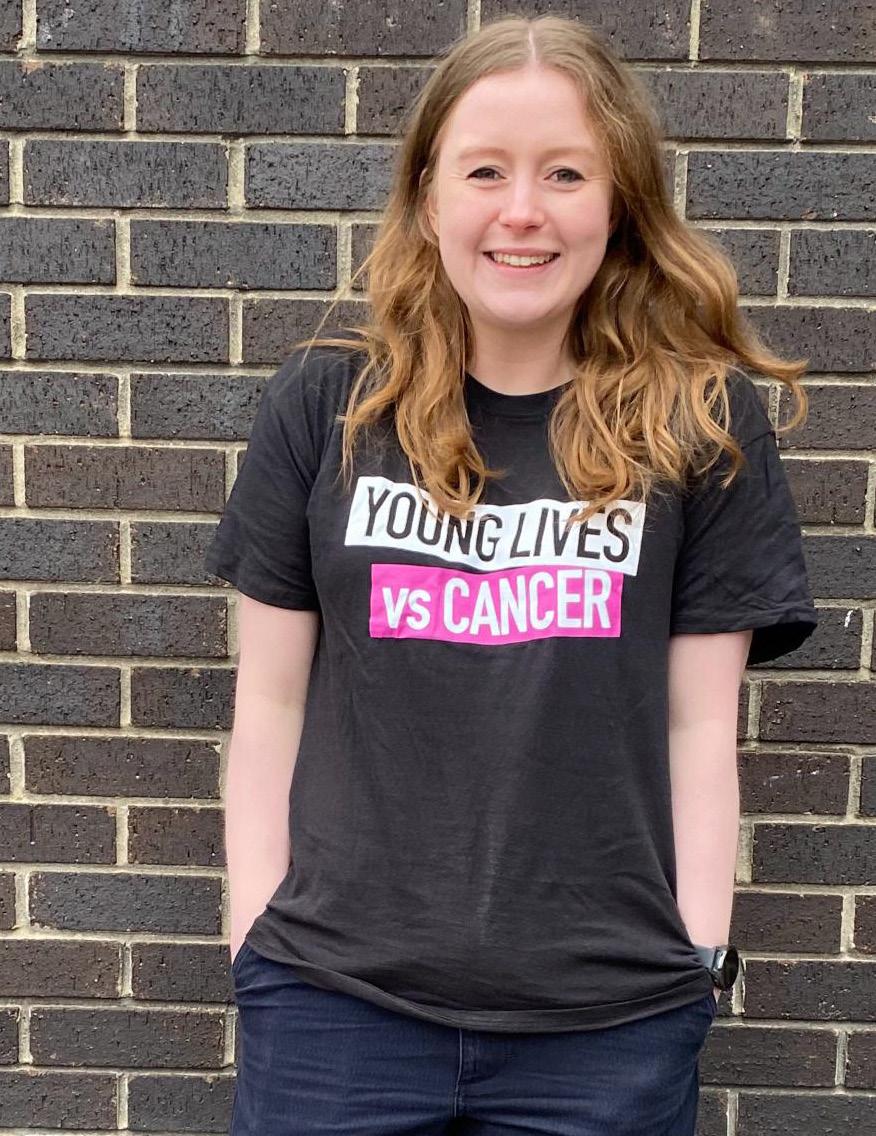
and experiences with others who were going through a similar journey. Anna developed new friendships during this weekend, and shared some of her own experiences during group sessions which was an important step for her.
In the next few months, Anna and her family will be completing her college application, and I'll be on hand to support them through this process. I’ll help to ensure Anna has the opportunity to continue her education in a setting that best meets her current needs. This may involve communicating with teachers, providing resources and information to the new college, and offering regular check-ins and emotional support to Anna and her family.
*Name changed for privacy
Advice for parents
www.younglivesvscancer.org.uk/ cancer-info-support/my-child-hascancer/my-childs-education
Advice for schools
www.younglivesvscancer.org.uk/ cancer-info-support/education/mystudent-has-cancer/
MORE INFORMATION
FOR
Contact Magazine | Issue 103 | Summer 2024 5

How robots are being used to support learning
Charlotte Bowling's daughter, Amelie, was diagnosed with acute lymphoblastic leukaemia (ALL) in June 2019 aged six. Charlotte tells us about the support her daughter and her family received from her school, including an innovative way of ensuring Amelie was involved even when not physically present.
To say Amelie’s diagnosis was a shock is an understatement. She’d been unwell with what we thought was a sickness bug, but we’d no idea this was one of the early signs of her illness. Within hours of being told she had leukaemia, we were transferred by emergency ambulance from our local hospital in Luton to Addenbrookes in Cambridge to start chemotherapy. Amelie then spent three weeks receiving high-dose chemotherapy in hospital while her dad, Darren, and I juggled being with her and looking after her brothers, Henry and Reuben. Thankfully, these initial stages of treatment went positively, and she came home in July, returning to hospital several times a week for more treatment.
Amelie received a mix of care at home from our community nursing team and inpatient treatment in hospital. At times, this was very difficult for her as well as the rest of our family. It’s hard to watch your child in pain, watch their hair fall out, refusing to eat, and then them gaining weight due to the mixture of drugs she required. She missed an incredible amount of school, gave up extracurricular activities and spent a lot of time at home due to the side effects of treatment.
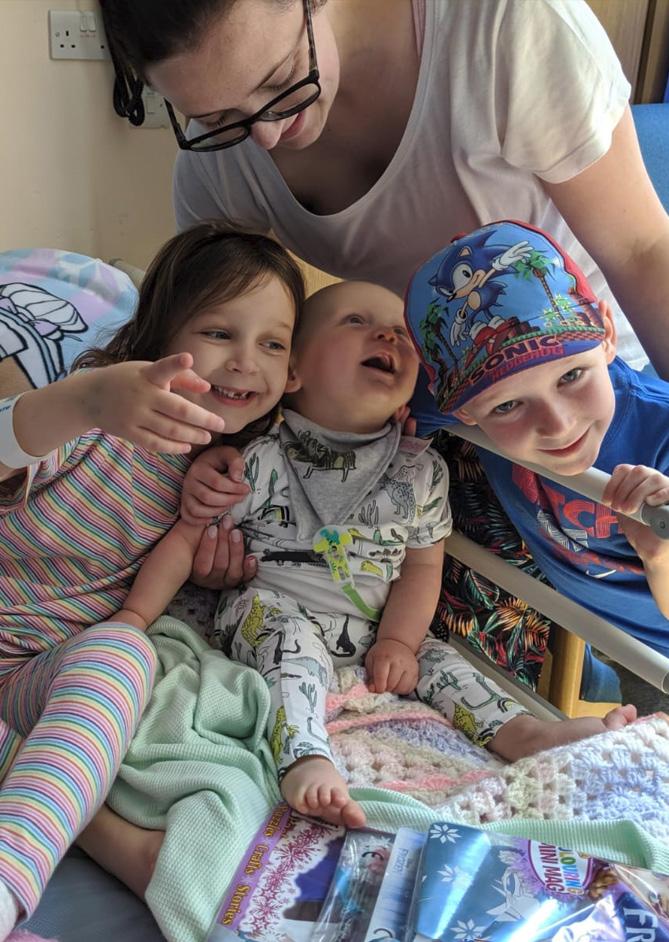
We were very lucky to receive incredible support from Amelie’s school, Putteridge Primary, which Henry was also then attending. The staff, pupils and wider school community went above and beyond to offer support to our whole family. In September 2019, just a
few months after diagnosis, Amelie returned to school part time. Although her health remained our priority, we wanted Amelie to return to some kind of normality and school was a part of that, both in terms of education and spending time with peers.
Our deputy head teacher, Nicola Chinnery, saw a piece on BBC News where another child was using an AV1 robot to attend school remotely and we were extremely pleased when we were able to get one of these robots via a scheme at Addenbrookes hospital. ‘Amelie-bot’ attended lessons when Amelie couldn’t, with the lesson streamed back to her iPad in our home or at her hospital bed. This was invaluable as it allowed her to keep up with her schoolwork and see her friends and be part of the class environment.
As Amelie moved to the later phases of treatment, she was able to attend school more and the staff supported her to catch up on the things she’d missed.
During her treatment, Amelie faced the everyday challenges all cancer patients face - looking and feeling incredibly different to everyone else, and battling with thoughts and fears you shouldn’t have to as a child. This could
Contact Magazine | Issue 103 | Summer 2024 6
Amelie in hospital with her brothers
have quite easily been compounded by her missing so much of her education, and peer and friendship integrations. We’re eternally grateful to the school, and the wider community, for working with us to find innovative solutions that meant Amelie wasn’t missing out. It provided a chance of fully reintegrating into education without facing a mountain to climb to be at the same academic level as peers.
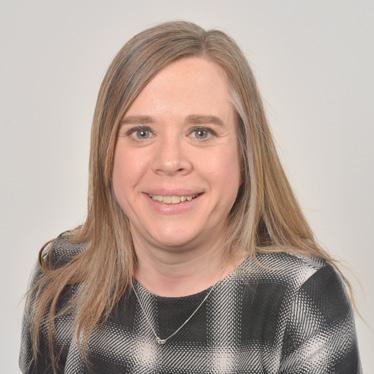
Amelie’s approaching three years post-treatment and is a healthy 11-yearold girl. Her hair’s grown back, she’s returned to doing all the things she loves and is full of energy. She’s sitting her SATs this year and is on course to do really well, which is testament to the unwavering support from the school.
Cancer is incredibly hard, and you never know how strong you are, until
The school’s
perspective
Nicola
Chinnery,
being strong is your only choice. In the face of such adversity, maintaining a semblance of normality can become not just a goal, but a lifeline. Focusing on education offered a sense of continuity and purpose. It was never just about keeping up educationally with Amelie, it was also about staying connected to the world beyond the illness, and to continue growing, learning and thriving.
Deputy Head, Putteridge
Primary School tells us more about how the school supported Amelie
At first, we felt quite under prepared as to how to support Amelie and her family. It was important for us to have clear lines of communication, so we set up one point of contact in the school. We wanted the family to know we were there to support them, and we made sure that pastoral support was put in place for Amelie’s older brother as he tried to navigate 'the new norm' of having a sister with cancer. During the early days, we reached out to our school community to support Addenbrookes and their ‘bravery boxes’ (used to give a child a treat after treatment, operations or procedures) which Amelie and her family were able to take to hospital. Her parents kept us informed as to how her treatment was going until we were at a point of Amelie trying to return to school.
A clear plan was put in place for Amelie’s return. We spoke to her class and shared books about children with cancer. Amelie and her mum came to visit so the children could ask any questions. Her fantastic nurse came in and talked to the staff in the year group about her treatment and Hickman line, and answered questions and concerns. We also had to consider the dangers of measles and other infectious diseases. The school sent out a letter to parents explaining the risks and asked them to keep us informed.
Amelie returned to school on a part-time timetable, which was agreed
with the education welfare officer. When she wasn’t in school, the work was printed out so she could access this at home. We also had to make sure she had access to resources at home, so we supplied a bag of maths resources, sound/spelling mats, art materials and anything else she may have needed to access lessons.
Support was also provided from Young Lives vs Cancer. They came in and did a whole-school assembly about children with cancer, while they also talked to staff and gave us advice on how to support her brother.
A new approach to learning
When the school was given the robot to support Amelie, the staff embraced it straight away. Amelie-bot was used when Amelie was unable to be in school, with any resources needed for the lessons photocopied for her. Amelie-bot came to assemblies, ate lunch with her friends and even took part in the Christmas party! The children and teachers soon got used to the robot. Amelie could see and hear everything that was going on in the classroom and could press a button so the robot’s head would change colour – this would indicate that Amelie wanted to answer a question or needed help. When COVID-19 hit, Amelie took part in remote learning using Google Classroom.
Once the Addenbrookes project finished, we had to return the AV1. However, Amelie was still going through treatment and needed access to a robot. Another parent found the charity SpecialEffect and its Bubblebusters initiative which loaned AV1 robots to schools. Amelie’s parents successfully applied for this, so we were able to continue with Ameliebot until she finished treatment.
Additional support was given to Amelie on her return, both pastoral and academic, while allowances were also made around her attendance and tiredness. She’s flourished since returning to school, thriving academically, and she even went on the residential trip.
CCLG'S PUBLICATIONS
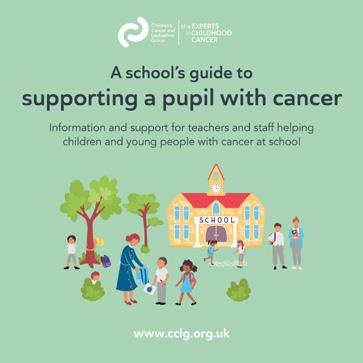
See the CCLG booklet, 'A school's guide to supporting a pupil with cancer'. Download or order FREE of charge friom our website at www.cclg.org.uk/publications
COVER STORY
Contact Magazine | Issue 103 | Summer 2024 7
back to basics
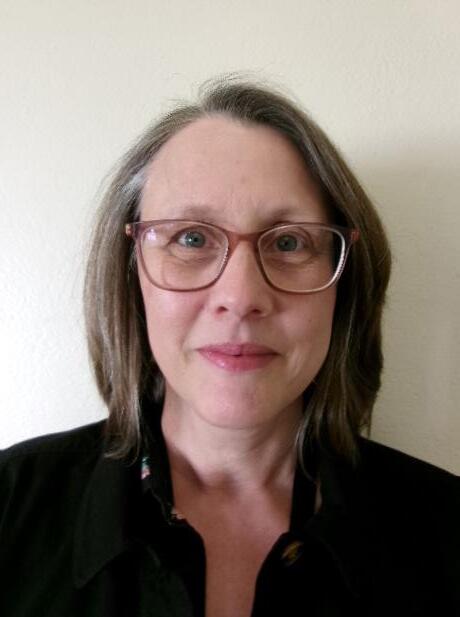
How will my child access education following their cancer diagnosis?
Education after a childhood cancer diagnosis
Parents and carers of children who have been diagnosed with cancer often have many questions about school and education.
Keeley McEvoy , Lead Assistant Headteacher of the Medical Needs Teaching Service working at Leeds Children’s Hospital, explains more about what to expect from hospital teaching, ongoing education support and transitioning back to school.

After diagnosis, a child often has a block of treatment in hospital. When the medical team agrees it’s appropriate, they’ll liaise with the hospital teachers about the child accessing education as an inpatient. Although the education offer may vary slightly between treatment centres, children will usually access a range of lessons across the week, delivered by teachers and support staff from the hospital school.
This often starts with a conversation between a member of the teaching team and the family to find out as much as possible about the child’s educational needs, as well as about their likes and dislikes - whether they love Minecraft, unicorns, Harry Potter or anything else. They’ll make sure they share this with the teachers who’ll tap into these passions as a starting point for encouraging positive engagement with learning right from the start.
Do hospital teachers communicate with my child’s school?
Yes. From the very beginning, with agreement from parents/carers, the hospital teaching team will communicate with your child’s school regarding education matters. The hospital school usually requests attendance and assessment information, in addition
to discussing any learning needs that your child may have. The aim is to find out as much as possible about your child’s academic work and about their individual interests so that the hospital teachers can support them effectively.
Throughout your child’s absence from school, communication between both sets of teachers (hospital and school) continues, ensuring sharing of relevant work, updates on progress and ongoing support for your child. Hospital teachers do their very best to ensure your child keeps up with the same work their friends are doing in school. Be reassured that the hospital teachers will never share sensitive medical information with school and will listen to any concerns you or your child might have about education, working together to break down any barriers to learning.
What are lessons like in hospital?
Each hospital school tends to have their own approach: children may be taught on a one-to-one basis at the bedside, in small groups on the ward or in a classroom space within the hospital. A daily timetable is in place to ensure that no one misses out on their education and liaison with the ward takes place each morning to check who’s well enough for lessons, with ward staff encouraging all to attend whenever possible.
Lessons are carefully planned, interactive and enjoyable. For example, science experiments are modified to make
them safe for the bedside, educational games are used as introduction or reinforcement and practical activities are prioritised. For teenagers, lessons will continue their GCSE studies and they can even sit exams in hospital if required. In all cases, infection control is always taken seriously. If your child's in protective isolation, measures are always taken to ensure safe delivery of lessons, balancing medical need with educational progress.
"Our teacher was fantastic. Lessons have been the highlight of my child’s day, keeping her interested and some level of learning continuing despite how poorly she has been at times… even on her darkest days when she was feeling really poorly she still wanted to do some learning."
Feedback from a parent at Leeds Children’s Hospital – March 2024
If my child’s receiving outpatient treatment and can’t attend school, what happens with lessons?
Local authorities and schools have a responsibility to ensure that children and young people receive home teaching if they have a medical need that means they can’t attend school. In some areas, the council organises the home teaching while in other areas it’s
Contact Magazine | Issue 103 | Summer 2024 8
the school that makes the referral to the home teaching team. It’s a good idea to ask your hospital teachers about this or encourage your child’s school to get in touch with the local authority to find out the arrangements for your area.
These lessons mostly focus on the core subjects: English, maths and science. An average of five hours of one-to-one home teaching each week is offered, alongside independent work as appropriate. If your child’s well enough to complete work in other subjects, schools can often offer further support. For example, most schools now have considerable resources available online that you may be able to access to supplement the weekly home offer. The home teachers will liaise regularly with school to support progress by requesting further work, updating assessment results or sharing information.
My child has specific learning needs. How will those be supported?
Make sure that you mention any specific learning needs that your child has when you’re talking to the hospital teachers and encourage their usual schoolteacher or special educational needs coordinator (SENCo) to contact the hospital school to share information.
Communication is the key to ensuring the correct support for every child.
Most hospital schools also have a SENCo, with specialist teaching available. If your child has an education, health and care plan (EHCP), this includes a range of goals and targets that are reviewed annually. The hospital school teachers are able to refer to these objectives when planning lessons and to actively seek opportunities to include activities that support progress with the EHCP targets. All hospital schools have access to resources, such as coloured overlays and sensory equipment that will support all types of learning needs. Furthermore, the teachers in hospital often have professional links with allied professionals, such as occupational therapists, play team members and speech therapists who can be consulted as needed.
What
about when my child returns to school? How will the hospital school help with this transition?
After a long absence, children often feel a mixture of excitement and nervousness when it’s time to return to school. The hospital school will support with this by sharing up-to-date education information, attending meetings prior to the child’s
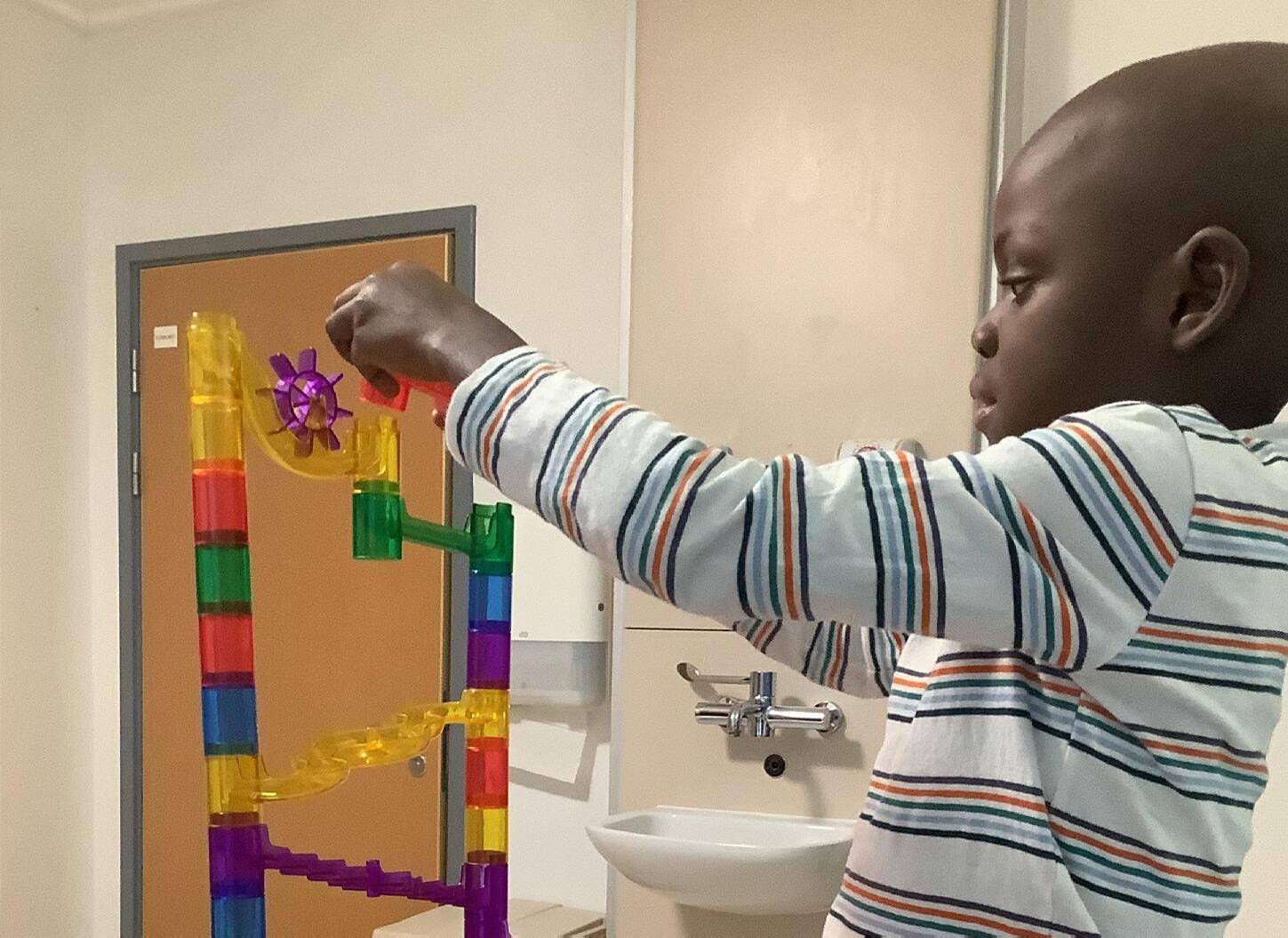
return and working with their clinical nurse specialist (or care team) to make the transition as smooth as possible.

op tips for a successful return to school
Plan ahead. Talk to the hospital teachers, school staff and clinicians to help with planning
Arrange one or two visits before the planned return date Going in for break time or lunch with a small group of friends works really well for a first session
Start with a phased return There’s no rush to be in school full time until your child is ready
Keep all lines of communication open. Ask for a designated link teacher to support with this
COVER STORY
Contact Magazine | Issue 103 | Summer 2024 9
p Benjamin being supported at Leeds Children's Hospital school

Educational support pathway after brain tumour treatment
Louise Robinson is a neuro-oncology outreach nurse specialist at East Midlands Children’s and Young Persons’ Integrated Cancer Service. Here, she emphasises the importance of collaboration and explains how a support pathway helps young patients with their education.
The return to education following treatment for a brain tumour is an important step on the road to recovery. However, it’s essential that schools have a good understanding of the child’s condition, and any new or emerging needs to ensure appropriate support strategies are in place.
For many children, attendance is possible during treatment, although often this is on a part-time basis or includes some home education or remote learning. Others may have prolonged periods of absence from education. Before returning to education, consideration should be given to the physical, psychosocial and cognitive impact of the tumour and its treatment, and any ongoing issues discussed with the school. A face-to-face or virtual meeting between the family, school and relevant health professionals can be an effective way of ensuring schools have a good understanding of pupils’ requirements.
The special educational needs coordinator (SENCo) is a key contact to involve and should oversee this process. An oncology outreach nurse with experience supporting children with brain tumours can enhance communication ensuring relevant information is provided, including written information and signposting to be shared with the wider educational team.
Though it’s essential to provide appropriate information at the time of the initial return to school, ensuring that this knowledge is shared as the pupil progresses through education is equally important. This is especially
true as children progress into secondary education, and pupils move from having one main class teacher, to working with multiple members of teaching staff. At the same time, expectations also often increase – not purely relating to academic work but also in terms of independence and social and behavioural aspects. Another important time point is preparation for formal exams. Access arrangements such as the young person being given extra time or rest breaks may be appropriate, and planning should begin well in advance of exams to ensure any arrangements become the pupil’s normal way of working.
In the East Midlands, the neuro-oncology outreach nurse and neuropsychology team have created an ongoing support pathway where children treated for a childhood brain tumour are screened at key educational points to ascertain the need for cognitive assessment and additional support. Recommended intervention points include:
starting pre-school and reception
year 5/6
transition to secondary school
year 10/pre-GCSEs
post-16 transition
As children progress through education, requirements may change or new needs emerge, therefore it’s essential that schools have regular and open communication with families. Support is available via specialist nurses and the multidisciplinary team or via the sources listed in the pull-out box.
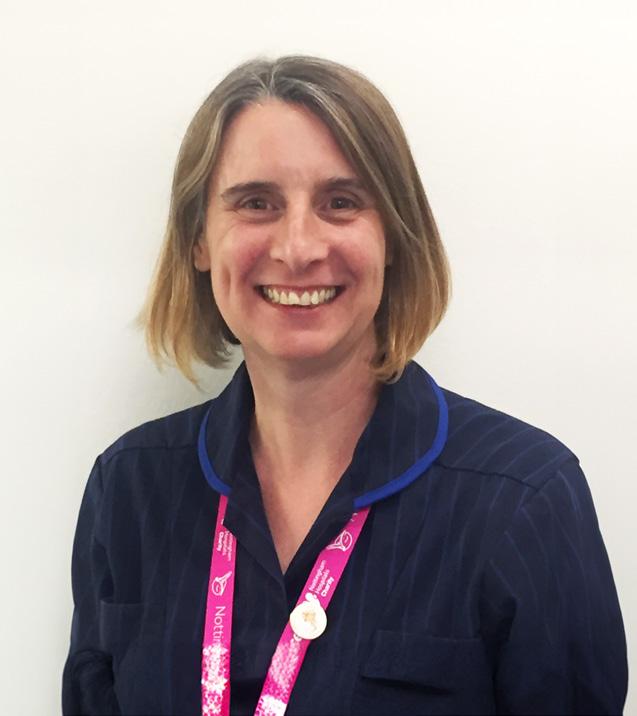
IF YOU FEEL YOUR CHILD'S NEEDS AREN'T BEING MET
This should, in the first instance, be discussed with the school SENCo. Funding is available to all schools to provide additional support, though for children with complex needs, an education, health and care (EHC) needs assessment may be helpful (see page 19). If granted, an EHC plan confirms the legally required support for the pupil and, in some local authorities, comes with additional funding. All local authorities must, by law, provide information and advice for children and young people with special educational needs or disabilities, and their parents. There is an information advice and support service in every local authority area. Details of this provision can be found in the local authority’s local offer website.
RESOURCES
AND SOURCES OF SUPPORT
www.bit.ly/Living-with-a-braintumour-TheBrainTumourCharity www.younglivesvscancer.org.uk/lifewith-cancer/my-student-has-cancer/ www.bit.ly/gov-publication-guide
www.bit.ly/child-brain-injury-trust www.bit.ly/the-childrens-trust-braininjury-info
Contact Magazine | Issue 103 | Summer 2024 10

In the years leading up to my diagnosis, I was suffering with severe migraines that would blur my vision and make me sick, while also dealing with severe anxiety. My anxiety was so bad that my school attendance was severely affected in year 10 and, when I finally went back, I did my work in my own room. My school was very supportive and was able to prepare me to go back into all my classrooms. Just as everything was starting to look up, the right side of my face went numb, which then prompted the doctors to finally refer me to a neurologist after two years of being turned away.
The neurologist sent me for an MRI, and I was then diagnosed with a pilocytic astrocytoma in the middle of my GCSE exams. The removal of this tumour left me with posterior fossa syndrome, meaning I had to learn how to walk, talk and eat again. I was given my predicted grades for the two exams I’d missed while in hospital. These grades were high enough for me to take the A-levels I’d chosen before my brain tumour was diagnosed.

How schools can adapt to flexible learning
Sophie Barclay was 15 when diagnosed with a brain tumour, making schooling and exams difficult. Now 18, she tells us how, with the support of her school, she has received a conditional offer for university.
I went back to school six weeks after getting out of hospital, and my school agreed to let me do my A-levels over three years, so I’d have more time to focus on my recovery. This meant that my first year was spent focusing on only one of my A-levels. While taking this A-level, it became evident that I wouldn't be able to write my exams out, like I previously had. This is because the posterior fossa syndrome has also affected my fine motor skills. Returning to school was a lot different to how it was before as I also got tired a lot quicker, which may have been because of how focused I was on my recovery.


My school offered extra support for my exams, which positively affected my results. They gave me 50% extra time taking them, they let me have rest breaks and they let me type my answers, so I didn’t have to tire myself out even more by writing. At the start of the course, I was getting near passes in my exams, and by the end, I was achieving merits.
The school also used my education, health and care plan to give me a learning support assistant to help me get around school and take any notes
I’d missed. This really helped me keep up with and focus on my work, knowing I didn’t have to worry about how I was going to get around school.
In the second year, I was further along in my recovery and was able to pick up my other two A-levels, with the support still in place from the school. While doing my three A-levels, I was still attending weekly physiotherapy appointments every Thursday. School wanted to make sure that my fatigue wouldn’t affect me too much, so they let me go home and rest in my free periods. In the second year, I also finished my first A-level, receiving a pass overall.
I’m currently in my third and final year of A-levels and have received a conditional offer from De Montfort University. I’m currently finishing off my final two A-levels and started my exams in May.
My advice for other young people going back to school following a cancer diagnosis is to keep going. At the start, it may feel overwhelming and different to how it was before, but if you stick at it, it does get better.
Sophie in hospital
Contact Magazine | Issue 103 | Summer 2024 11
Sophie attending her weekly physiotherapy sessions
Why working together is so important
Naomi Duxbury’s daughter, Mia, was aged four when diagnosed with B-cell acute lymphoblastic leukaemia in September 2021. Here, she tells us about the importance of working closely with Mia’s school to create a safe, supportive and ‘normal’ learning environment for her.
What was supposed to be Mia’s first day of school was instead her first day of chemotherapy. Her treatment finished just over two years later in November 2023, and she's now in remission. Although it's been a long road, with a few bumps along the way, we’ve been supported by her school from the very beginning. As soon as Mia was diagnosed with leukaemia, we informed the school of her diagnosis and that she wouldn’t be starting for some time. We were heartbroken that Mia would miss her first ever day.
Mia’s school was very supportive and understanding and her teachers even called us to check to see how she was while she was in hospital. During that time, the teachers explained her diagnosis to her class. Mia had attended pre-school with a lot of those children, so they were made aware that she may look poorly and may not have much hair. The children and her teachers made her cards and a scrapbook and when she was able to go to school, they were all so excited to see her and were so caring and made such a fuss over her.
To help prepare them to support Mia, her teacher and head teacher went on a training course. They didn’t have to do this and did this on their own initiative, which reassured us that when she did return to school, she was in safe hands. Once Mia was discharged from hospital, her Macmillan nurse, Neil, and her dad, Jacob, had a meeting at the school. Neil created a care plan and risk assessment and discussed various things such as treatment side effects
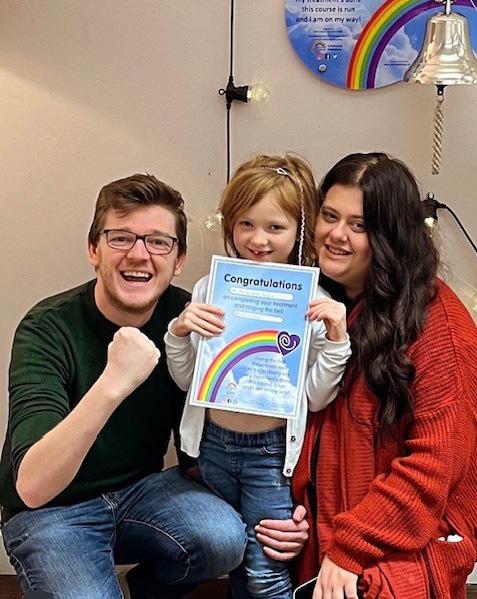
and her nasogastric tube and portacath. He also explained that as Mia was immunocompromised, should anyone have measles, shingles or chickenpox in school, and she had direct contact with them, then we'd need to know as soon as possible.
To help prepare them to support Mia, her teacher and headteacher went on a training course. They didn’t have to do this and did this on their own initiative, which reassured us that when she did return to school, she was in safe hands.
Mia’s school was great, issuing a letter to all parents explaining everything. In the school’s weekly newsletter, it always said that parents/ legal guardians should inform the school immediately if their child had measles, shingles or chickenpox. Any time they’ve been informed of this, the school staff have always told us straight away. The call would always start with, “Don’t worry, Mia’s okay, but we want to let you know there’s a positive case of chicken pox”.
p Mia with her dad and mum, Jacob and Naomi
We know first-hand how important it is that this is communicated to us, as during the last summer holidays, Mia spent most of the time in hospital as she contracted chicken pox, which turned into shingles and resulted in kidney damage, and we had to cancel our holiday. Nurse Neil was very impressed with how well Mia’s school listened and actioned everything to ensure Mia’s wellbeing and safety at school.
The first six months of Mia’s treatment was the most intense. During this time, Mia went into school twice a week and did half-days, while we made sure she didn’t miss out on class photos or special events (including the Christmas show, where she was a little angel) and the school was very happy for Mia to come in and take part. We were given learning packs for Mia to do at home, but it was also emphasised to us that if she didn’t feel up to it then it was absolutely fine. Neil said it was very important that Mia had as much normality in her life as possible so when Mia felt well enough, we ensured she went to school.
As Mia’s school teachers and staff were so supportive and accommodating, and ensured they educated themselves and took the time to learn and listen about her diagnosis and additional needs, we felt reassured that she was safe and looked after when there. As Mia progressed through treatment, we started increasing the days and hours in which she was in school, basing this on how Mia was doing while also working it around treatment at
FAMILY STORY Contact Magazine | Issue 103 | Summer 2024 12

hospital. We went from half-days to two or three full days and then, eventually to full time which started when she was in year one. Everyone at the school was so understanding during this time. They allowed community nurses to come in to do weekly blood tests, and never once complained when Mia couldn’t attend due to being poorly or having hospital appointments.
Receiving extra learning support
Mia was on treatment from reception to the beginning of year two. This included hospital visits, admission, community nurse visits and illness due to side effects of being on treatment and being immunocompromised. As a result, Mia missed out on quite a lot of school, and did start to fall behind, particularly in phonics. Mia’s head teacher proposed that she started 15 minutes early every day so they could do extra phonics learning. She still does this now and has come on leaps and bounds in this subject, and we can’t thank the teachers enough for taking the time to sit with her every morning and help her with this.
When Mia finished treatment, her school allowed her to do the end of
treatment poem and ring the bell during school assembly, which all the children and staff were so excited about and a few of the teachers even cried, having also been on this journey with Mia and us as a family. Mia’s school has also helped fundraise for Candlelighters, who have supported us as a family throughout this process, and they even had people from the charity do an assembly, knowing how important it is to raise awareness about childhood cancer.
Mia really enjoys school, though not so much the early mornings! I love hearing all about what she’s been learning at school, and she gets so excited telling me, her dad and grandad about everything she’s learnt that day!
What I’d say to other parents
My advice for parents or guardians with children who are due to start school or are returning to school while undergoing treatment is to make sure you express any concerns you have with the school and be completely transparent with them. You also know your child better than anyone else. I’d also say let your child take the lead with what is and isn’t too much. Don’t be afraid to let them go to school
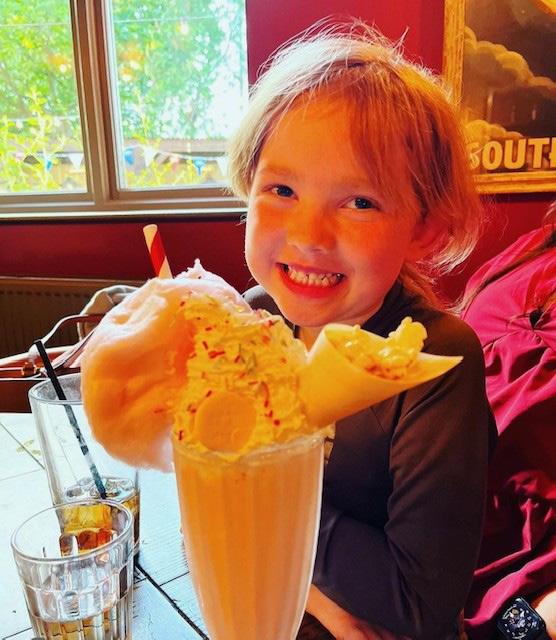
and escape the reality of having cancer. Let them have a little normality in their life and be like any other child. It is scary, and the first few times they attend school you’ll be constantly checking your phone, but the anxiety does ease away gradually.
Looking to the future
Mia, who is now seven, originally wanted to be a nurse or doctor after seeing the procedures being carried out while on treatment and then acting them out on her teddies. She’d perform surgeries and ask mummy to stitch her teddies back up! Now she’s older, she’s into her gymnastics and loves animals. So, when I asked her what she wants to be, she said either a vet, like her Auntie Jenny, or a teacher, just like the amazing teachers at her school. Clearly, she’s been inspired! Since Mia has been at school full time (aside for absences due to illness, which still occur as she’s still prone to catching bugs etc.), she's come on leaps and bounds. That’s thanks to the school for being so supportive and accommodating of her educational and medical needs. I’m very excited to see how far Mia progresses with her education and no doubt she'll continue to shine and excel, thanks to herself and the teachers and staff at her school.

Contact Magazine | Issue 103 | Summer 2024 13
“Moving schools turned out to be a great decision”

Ruby Abramow was first diagnosed with a rare head and neck cancer aged nine, before relapsing in 2019, when she was 14. Now 19, she tells us how a new, supportive environment gave her the fresh start she needed to take back control of her disrupted education.
I was first diagnosed with cancer in 2014, after my mum brushed my cheek and felt a large lump. Worried, she booked an appointment with the GP, but they weren’t concerned. However, following an appointment at the dentist, I was immediately referred for an ultrasound of my face, which showed a golf ball-sized lump in my left cheek, in my salivary gland.
A biopsy found I had a cancer called acinic cell carcinoma and I was swiftly sent in for surgery, which was successful. I went into remission but, after five years, my cancer returned when I was in year 10 at school. Thanks to the diligence of NHS staff and regular scans we were able to find the tumour in its extremely early stages. Despite this, I was in hospital for a long time as I had to be fed by a tube because of the surgeries I had. Mine and my family’s lives were completely flipped upside down, with me missing out on months of school and my parents having to take a lot of time off work to care for me.
When I was finally able to return to school, COVID-19 hit, and the country went into lockdown. This meant I missed even more of school and though my teachers passed me for my GCSEs,
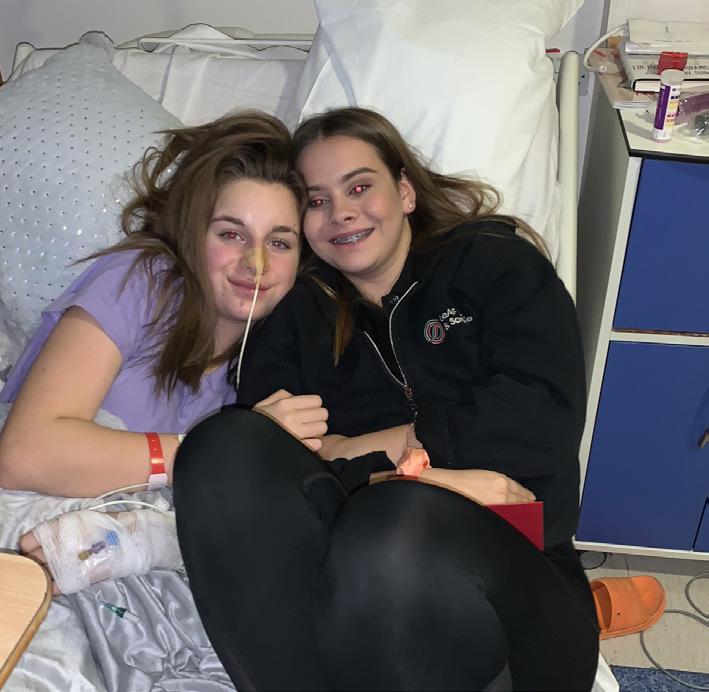
they weren’t what I was hoping for. I’d missed so much content and received little support to help with my needs and catching up.
A fresh start
Before I started sixth form to do my A-levels, I decided to move schools, which turned out to be a great decision. I had a lot of friends there from performing arts, who all said what a great environment it was. My new school was so accommodating, and the teachers were some of the most inspiring women I've ever met. I became really close with them, and they couldn’t do enough for me.
They were able to authorise all my doctor’s appointments, and I got lots of additional help when I missed lessons due to appointments or scans. When taking exams, I was allowed to use a laptop and sit them in a quieter room, instead of a big hall, which helped hugely with the anxiety I was feeling.
"My new school was so accommodating, and the teachers were some of the most inspiring women I've ever met. I became really close with them, and they couldn’t do enough for me."
What else helped me?
For me, another plus was that the new school had better facilities for performing arts, which has been a big part of my life. I first started performing just before my first diagnosis and I only stopped a couple

of years ago because I just wanted to focus on my education. I've always been very musical and after my second diagnosis, I think it was very important for me to have an outlet to express myself. I started songwriting, too, and I found all of it really therapeutic.
In academic terms, as well as the support from my teachers, I took it upon myself to get a tutor. I worked hard and was really focused on what I wanted to do. I also took on some leadership opportunities at school, like becoming a prefect, to really boost my personal statement for applying to university. A lot of people start this process when they’re 14 or 15, but this was when I was in hospital. I had a bit to catch up on, so I threw myself into extracurricular activities as well.
Why I’m excited for the future
I’m pleased to say that all the hard work paid off. I’m now studying public health at the University of Nottingham and applying to graduate entry medicine next year. My cancer experiences sparked a passion in me for medicine and my dream is to become a paediatric oncologist, so I can support children and their families in the same way that others did for me.
COVER STORY
Ruby during A-level celebrations with friends
Ruby and her friend, Alex
Contact Magazine | Issue 103 | Summer 2024 14
A parent’s view...
Facing challenges with the education system
Lauren Bryce’s son, Alfie, had just begun his final year of school when he was diagnosed with leukaemia, aged 15. Here, she tells us about their struggles with the education system after his diagnosis and what could have helped him as he prepared to take his GCSEs.
Just two days into Alfie’s final school year, he was very unwell. The memories of the days that followed are hazy, but he was very quickly transferred to hospital and was diagnosed with acute myeloid leukaemia (AML). Alf endured his first round of chemotherapy like a champ, but unfortunately this didn’t have the desired effect and his leukaemia wasn’t responding to treatment. He started an early phase clinical trial, which got him into remission, and he then had a stem cell transplant with his youngest brother, Bertie, being his donor. Alf remains in remission and is recovering well, with some
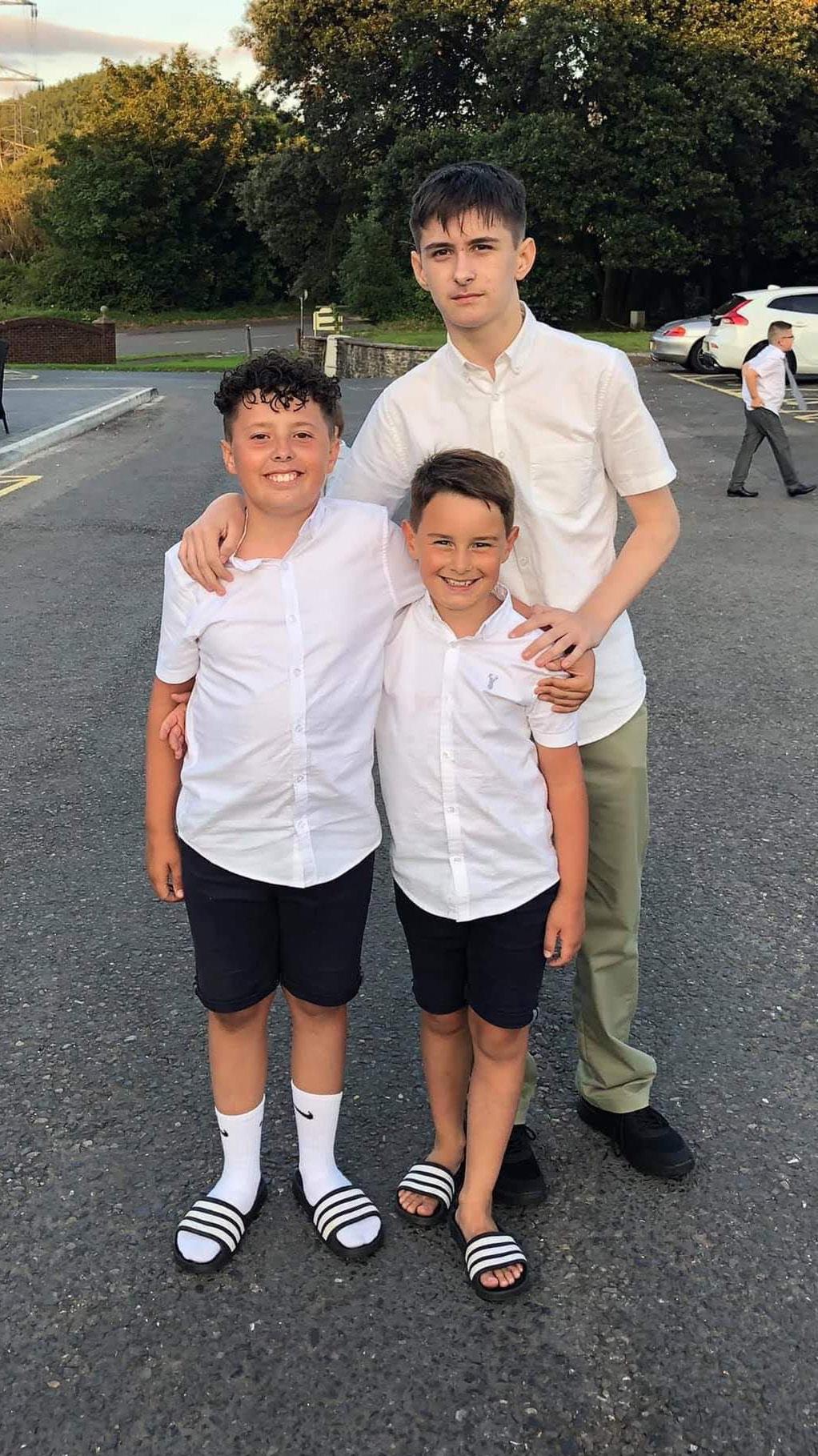
Alf received all chemotherapy and his stem cell transplant as an inpatient, which treatment and during most of his six-month
school work. This has meant that Alfie did not sit any GCSEs, and his last ‘normal’ school year was year 8, due to COVID-19

lockdowns and then his cancer diagnosis. Alf has started college, but due to his lack of qualifications and confidence with academia he started on an independent life skills course. He’s enjoyed his time at college, even if they do question and require proof of every absence, which is quite frequent due to his appointments! And it’s difficult for us to prove he’s genuinely unwell post-bone marrow aspirate. However, it has allowed him to get into a routine of getting up, navigating public transport and spending the day with his friends, which he has enjoyed.

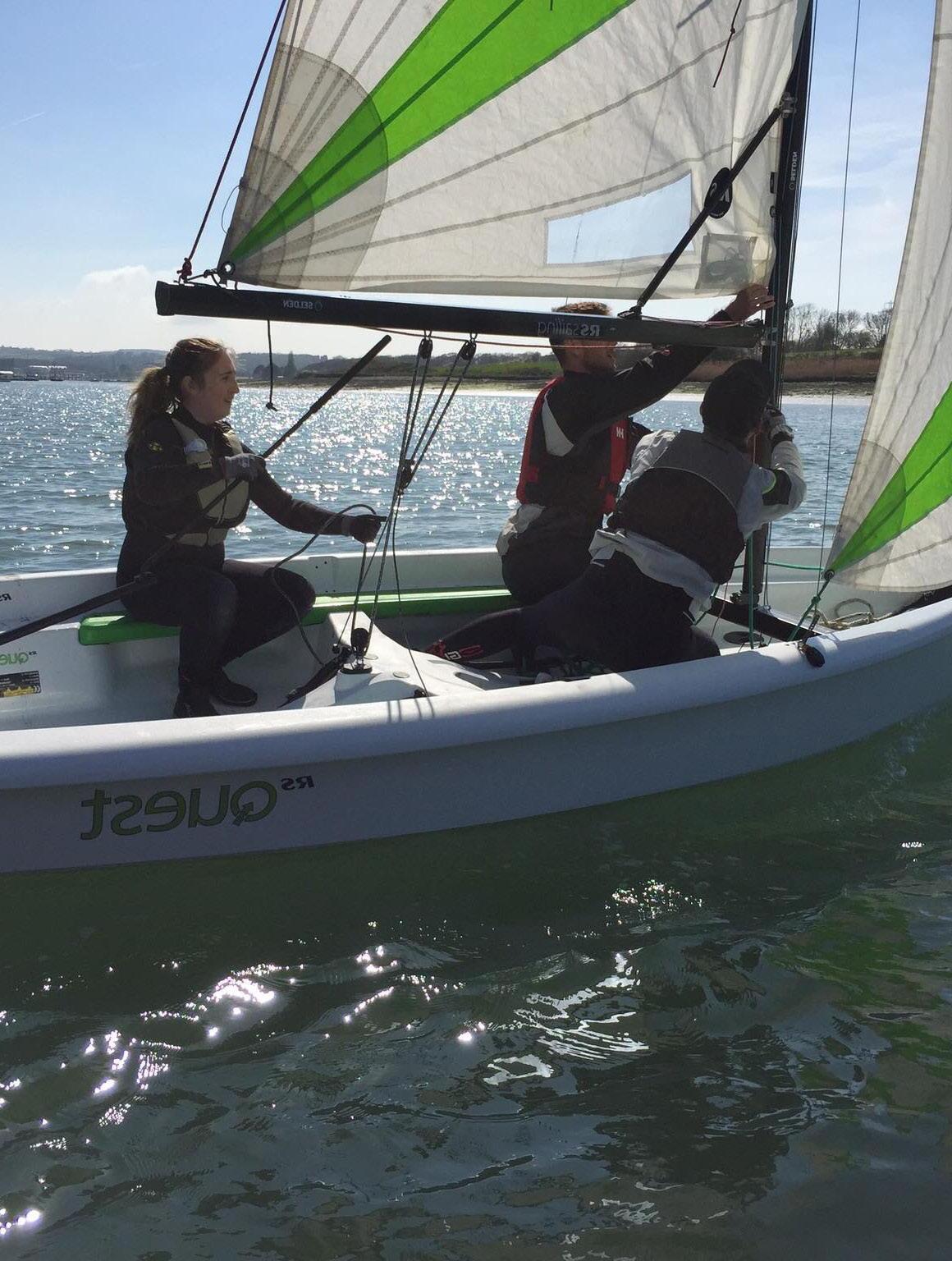
Alf is hopeful to go onto a mainstream course in September, though it will have to be a foundation level course due to his lack of GCSEs and he’ll need to sit maths and English alongside it, but we know this will build stepping stones to a bright future for him.
Lillie and friends sailing
COVID-19 proved that there are many alternatives to educating a child away from a school setting. There were also allowances made for young people in their final years of schooling during COVID-19. For example, they
without taking exams. We’ve been left wondering why these allowances can’t be extended to help children like Alf, and it’s very disappointing that they aren’t.
Alf did spend an hour or so a week with a hospital tutor, Isabelle, who was a welcome presence when he was feeling up to it. It was a distraction from treatment and someone who wasn’t his mum or dad. And, if school had been more supportive, Isabelle could have liaised with them to provide work that was similar to his classmates, giving them common ground to chat about while gaming in the evening! Even if they assisted us in all working together to follow the curriculum, maybe he could have completed a coursework-based qualification or possibly one or two exams.
Alf is now two-years post-stem cell transplant, and it will be a few more years before he finishes education with qualifications that match his peers. However, we've no doubt he'll get there, and he isn’t in a rush to be an adult, even if he's now 18!
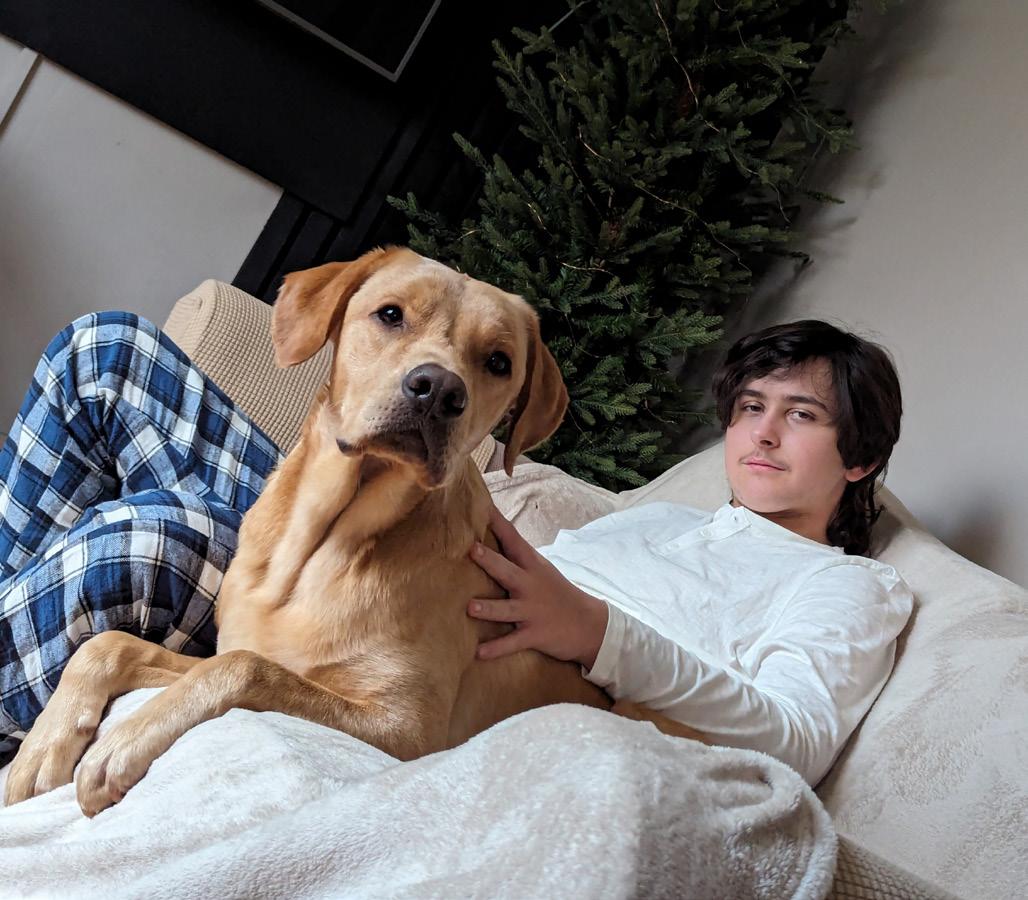
COVER STORY
Lauren and her son, Alfie
Alfie with his younger brothers, Ollie (left), and Bertie, days before diagnosis
Alfie and his post-cancer wish puppy, Llewi
Contact Magazine | Issue 103 | Summer 2024 15
Aflie at Christmas, post-transplant
"The
first day back at school was scary, but exciting"
Lily Morris was diagnosed with acute lymphoblastic leukaemia (ALL) in 2022 aged 15. Now 16, she tells us about its impact on her GCSE preparations, and the support she’s received from her school and friends as she transitioned back into full-time education.
The day before my diagnosis, I’d been to A&E, but was sent home without having any tests, and told to come back if anything worsened. When I woke in the middle of the night being sick with bad headaches, I went straight down to a children's A&E in Brighton. I was seen immediately, having blood tests and cannulas put in, before being moved to a ward.
That evening, the nurse who was looking after me asked my mum if my dad was able to come to the hospital and that's when we knew something was really wrong. When he arrived, the doctors took my parents into a separate room, before they came back a few minutes later, crying. I was then told I had leukaemia.
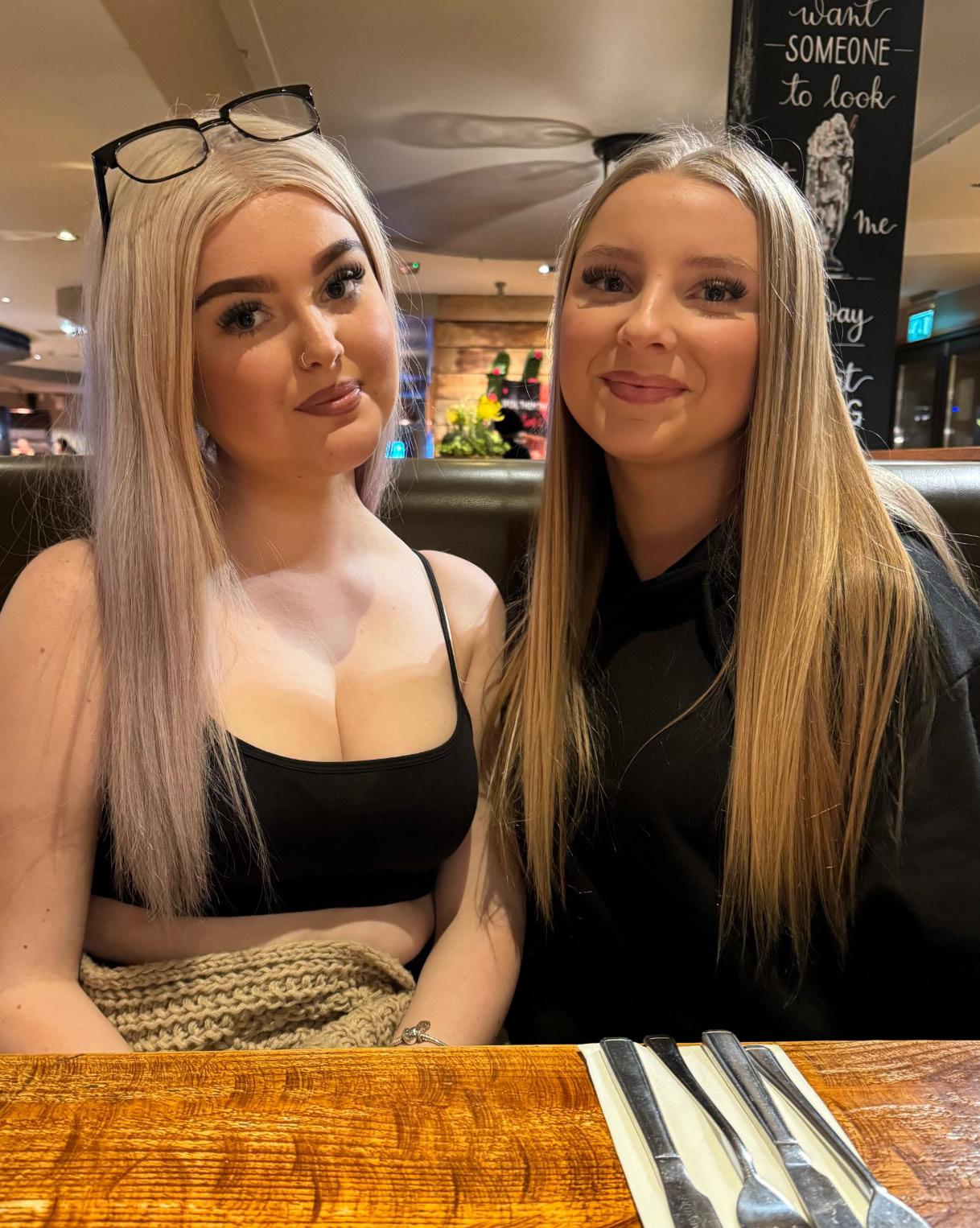

My nurse answered all my questions, but I also couldn't help but cry the whole time. I stayed in overnight and the next day I was transferred to St George’s in London, where chemotherapy started as soon as I arrived. I was there for six weeks and spent a lot of time in Brighton, too. I couldn't go to school for six months, which meant I missed nearly the whole of year 10. Year 10 is the most important year of your education, getting ready for your GSCEs the following year. Losing that time meant being behind everyone else.
The first day back at school was very scary, but also very exciting as I got to see all my mates again for the first time in months. School felt very different, though. I was wearing a wig and had some people staring at me as they didn't know about my diagnosis, so it did feel very weird at times. I started off by doing half-days and going home at lunch but thought that maybe I could start doing full days to try and catch up with all the things I'd missed. This went well, and as I’ve returned to school full time, I’ve managed to slowly catch up with everyone in my year.
My school supported me so much by letting me drop subjects I'd been finding difficult and by adjusting to my needs. My friends have also been a massive help during this incredibly hard time in my life. They’ve supported me by making sure I'm okay on the days where I don't feel good, or on days where I'm having chemotherapy, they adjust plans to ensure they include me. For example, if we go out, they make sure that I don't have to walk very far because I get tired quickly. They also make sure I've had my medication staying at their houses overnight and, in school, they make sure I'm feeling okay
p
in myself. My medical team also support me in what I want to do in the future and always make sure I'm feeling okay. They’ve also helped by suggesting charities that could help me and my family with certain things, like getting extra help with schoolwork and with money.
"My school supported me so much by letting me drop subjects I'd been finding difficult and by adjusting to my needs. My friends have also been a massive help during this incredibly hard time in my life."
I’m now taking my GCSEs and prepared for them with mock exams. They were all hard due to everything I missed, but I gave it my best go and did well. If anyone’s in a situation like me at school, my advice is to do the same and give it your best. You don't always need good results to go to college and you can always do your exams again.
I’m now looking forward to having the best time at my prom and then I want to go to college and do a hairdressing course. Things do get easier, and good things come to all people that wait. Don't let anything stop you from living your best life.
Lily and her best friend, Maddie
Lily and her brother, Alfie
Contact Magazine | Issue 103 | Summer 2024 16
Delivering packaged drugs into paediatric brain tumours using ultrasound
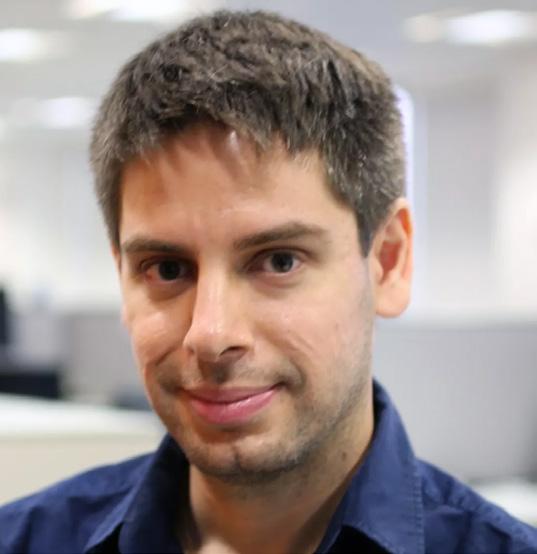
Dr Antonios Pouliopoulos

PROJECT TITLE: Focused ultrasound and thermosensitive liposomes for paediatric brain tumour treatment
LEAD INVESTIGATOR: Dr Antonios Pouliopoulos
INSTITUTION: King's College London (KCL)
AWARD APPROX: £850,000 (Funded by The Little Princess Trust in partnership with CCLG)
Diffuse midline glioma is a devastating brain tumour, affecting primarily young children. There’s currently no cure for this disease and treatment options are limited. This is mainly because this type of tumour is well-protected from drugs by the ‘blood-brain barrier’. This barrier physically blocks all medications from entering the brain. Our group has developed new methods of bypassing this barrier using focused ultrasound. Our aim is to effectively deliver medication into diseased areas in a patient-friendly manner, without affecting healthy tissues or inducing detrimental side effects.
The Little Princess Trust-funded project combines two main aspects: ultrasound therapy and new drug carriers, called liposomes. Liposomes are small liquid pockets that can be loaded with powerful drugs. We collaborate with Prof Maya Thanou at KCL, whose group has developed liposomes that are sensitive to heat. In other words, they release their contents, such as chemotherapy drugs, only when heated.
We aim to deliver these liposomes in the brain tumour using focused ultrasound, and to release chemotherapy drugs specifically within the tumour by mildly heating the affected area. We also work with Prof Darren Hargrave and Dr Elwira Szychot from University College London/Great Ormond Street Hospital, who are clinical
experts in diffuse midline glioma and provide invaluable insights from the patient’s perspective.
"Our aim is to effectively deliver medication into diseased areas in a patientfriendly manner, without affecting healthy tissues or inducing detrimental side effects."
What
results can you share from the project?
So far, we’ve designed and produced liposomes that carry drugs specifically to the brain tumour we’re trying to treat. We can see the delivery of these liposomes through scans like MRIs, and we know that we can deliver the liposomes into brain tissue due to our work on laboratory models. Now, we're making sure we can deliver the drugs into the brain tissue. Our future work will be focused on evaluating the effect our new treatment has on survival in the lab.
What does this mean for young cancer patients?
If successful, this project will pave the way towards more effective and kinder treatments for young brain cancer patients. Currently, a limited amount of medication developed for this type of brain tumour reaches its target. Also, high systemic doses mean considerable side effects for young patients. We want to kill two birds with one stone, by reducing the total administered dose while increasing the delivered dose to the right location. This approach is completely non-invasive and painless, providing an excellent example for future personalised and comfortable treatments.
Will this influence any future research?
We hope that our project will lead to future clinical trials for diffuse midline glioma patients. Our team is aiming to be the first to treat a paediatric brain tumour patient with focused ultrasound in the UK in the near future. We believe that our project outcomes will open new avenues for device-drug combination approaches offering personalised treatments.
www.cclg.org.uk/ourresearch-projects
RESEARCH FOCUS
Contact Magazine | Issue 103 | Summer 2024 17
Gail Beaumont
Gail Beaumont, hospital teacher at Sheffield Children’s Hospital
Q: Tell us about your career so far?
A: I came to work at Sheffield Children’s Hospital 30 years ago, to be the teacher on the oncology and haematology ward. I’ve been here ever since and have never wanted to work anywhere else. I'm part of a wider and fantastic team at Becton School, part of Nexus MultiAcademy Trust. We’re a hospital school with three separate provisions, one of which is Sheffield Children's Hospital. It’s a privilege to work with the amazing young people and families that I’m lucky enough to meet in my job. They teach me so much about resilience and courage, and I think I have the best job in the world!
Q: Tell us about your role in supporting young people with cancer and their families?
A: My primary role is to help young people continue with their education, and to support them in transitioning back into school when that time comes. It’s very important that school is delivered in a way that's fun and accessible, so I try to make lessons as imaginative and interactive as I can. The teaching support that our students receive is bespoke to their needs and usually one-to-one, so I can target specific areas that a student needs extra help with.
I think it’s very important to listen to the children and their families about what it is they want and need in terms of education. My job's to support them in whichever way removes any worries or anxiety they might have around school and education. This could be by following a formal educational pathway, or it might be by offering enrichment activities, or sometimes, it might simply be the opportunity to talk.
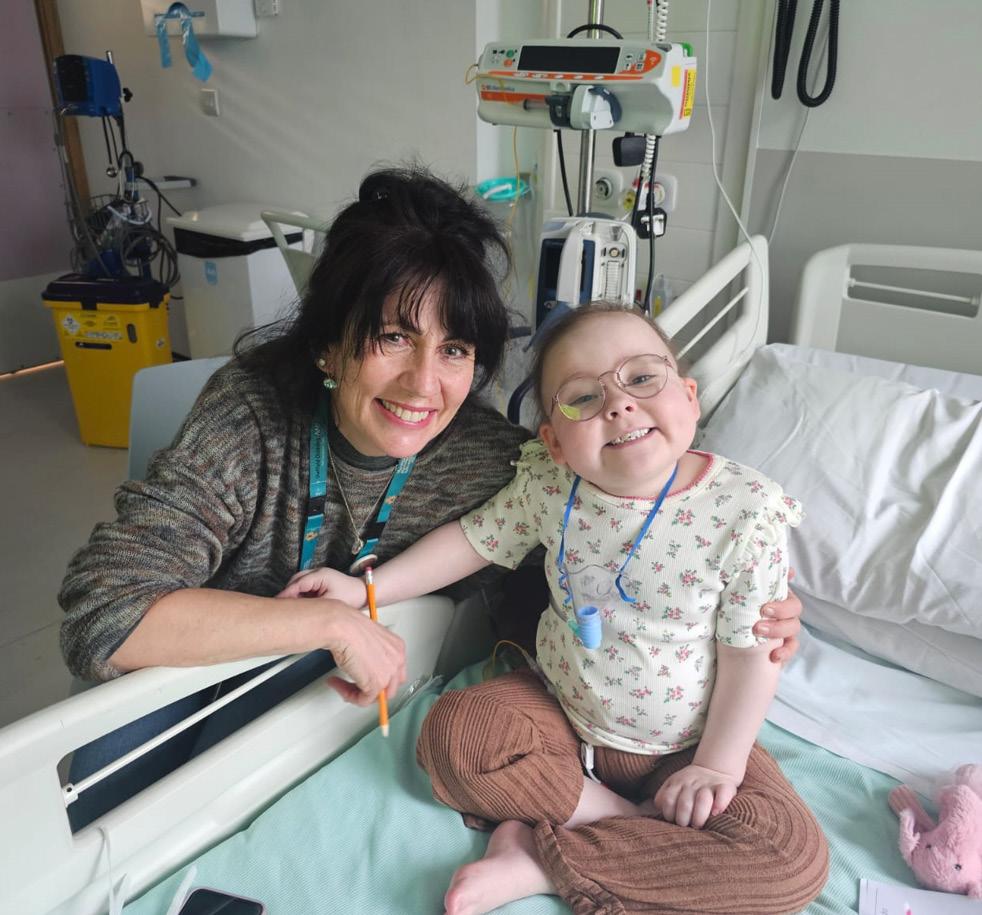
Q: What's the most rewarding part of your job?
A: Every day is rewarding! It’s a rare thing, I think, to have a job where every day you can maybe make someone’s day a little bit better. The most rewarding times are those small moments where you see pride in a piece of work completed, or excitement from a young person that it’s time for school. It’s always wonderful when you hear from students a few years on from treatment and see they’re out there in the world doing ‘their thing’, having known the courageous journey that got them there.
My job is to support them in whichever way removes any worries or anxiety that they might have around school and education.
p Gail with one of her patients, Florence
Q: What does your job mean to you?
A: After all the years I’ve worked with our oncology and haematology patients at Sheffield Children’s Hospital I’ve never lost sight of how privileged I am to do the work I do. I’m overwhelmed every day by the bravery and resilience of our young people and their families, and it’s humbling to be allowed into their lives at what is such a difficult time.
Q: Do you have a message for children with cancer and their families?
A: There are no rules about what you should or shouldn’t do or feel. You should do whatever works for you to help you through – don’t put any pressures or expectations on yourself. It’s okay to feel however you feel, and it’s important to tell people how you really feel. Reach out for all the support and love that is around you. Remember that people really want to help – accept and embrace the strength that you can draw from other people.

p The Becton School teaching team dressed up for World Book Day
60 SECONDS WITH
Contact Magazine | Issue 103 | Summer 2024 18

Emily Varley, a school special educational needs and disabilities coordinator (SENDCo) based in Leicestershire
What is an education, health and care
plan (EHCP)?
This legal document in England outlines the support a child or young person with special educational needs or disabilities (SEND) will require and receive. Different plans are available in other UK countries: in Wales, you can get an individual development plan; in Scotland, an additional support plan; and in Northern Ireland, a statement of special educational needs.
How will it help my child?
Covering education, health and social care needs, it’s designed to ensure a child receives appropriate support to achieve their full potential. The personalised plan involves both the parents and the child/young person in the decision-making process about their education and required support. It outlines outcomes to be met within a given timeframe (for example, by the end of a key stage) as well as through transition periods (between key stages or into adulthood), to ensure continuity of support. The plan includes provisions to be implemented to achieve the outcomes and having an EHCP can also grant access to additional resources, like specialist teaching, therapies or equipment.
Who’s eligible?
Local authorities will consider a wide range of evidence, including:
• academic achievement (or developmental milestones in younger children) and rate of progress
• information about the nature, extent and context of the child or young person’s special educational needs (SEN)
• evidence of action already being taken to meet their SEN
• evidence that where progress has been made, it's only been as the result of much additional intervention and support over what's usually provided
• evidence of their physical, emotional and social development and health needs
What’s the application process?
A request for an EHCP assessment can be requested any time through your local authority. The request can
be made by a parent, a young person over the age of 16 but under the age of 25, or a person acting on behalf of a school.
The whole process of EHC needs assessment and EHCP development, from the point when an assessment is requested (or a child or young person is brought to the local authority’s attention) until the final EHCP is issued, must take no more than 20 weeks. Local authorities must give their decision in response to any request for an EHC needs assessment within a maximum of six weeks from when the request was received. If a local authority decides, following the assessment, not to issue an EHCP, it must inform the child’s parent or the young person within a maximum of 16 weeks from the request for a EHC needs assessment, and the child’s parent or the young person must be given 15 calendar days to consider and provide views on a draft EHCP and ask for a particular school or other institution to be named in it.
Where can I get support in getting the EHCP?
If you’re a parent, speak to your child’s school SENDCo for information about interventions, assessment data and progress of your child. Special Educational Needs and Disabilities Information Advice and Support Service is a free, impartial and confidential service, available through your local authority, offering information to young people and their parents/carers. Independent Provider of Special Education Advice (IPSEA) is a charity that provides support with SEND law.
If your child isn’t eligible for an EHCP but still needs help, communicate openly with your child’s school and healthcare professionals to explore the available options to support your child’s needs.
ASK THE
Expert
Contact Magazine | Issue 103 | Summer 2024 19

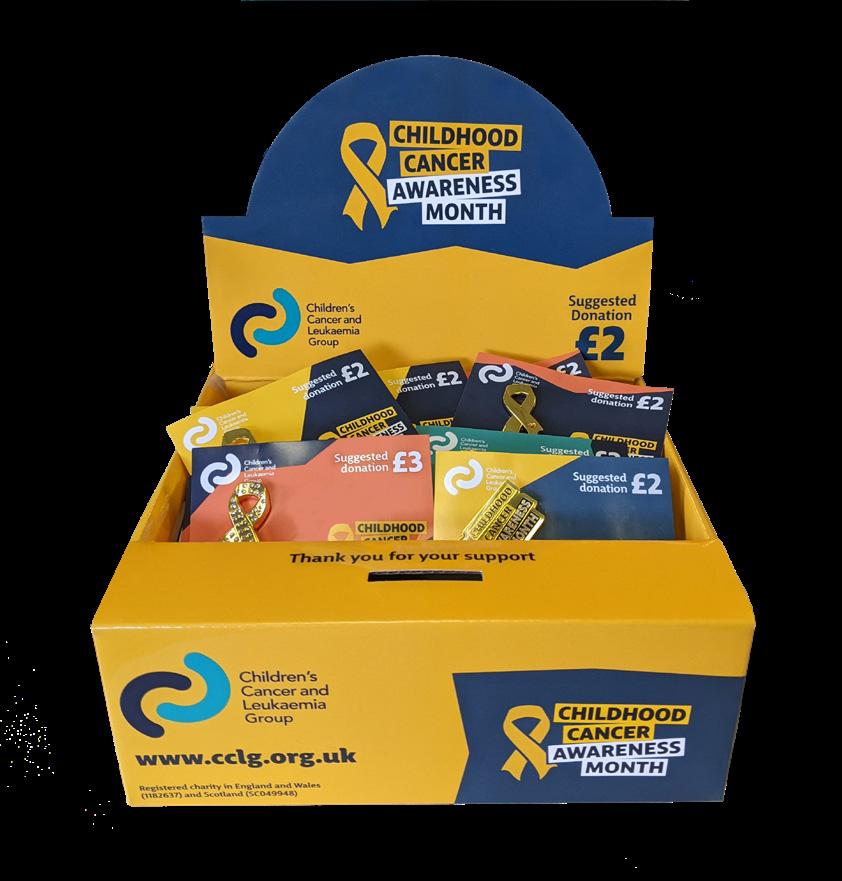
Get involved and help change the future for children with cancer
Wear It Gold
Whether at work, school or out in the community, organise a ‘Wear it Gold' day and ask others to join you and donate to make a big impact
Bake It Gold
Host a ‘Bake it Gold’ event and gather friends, family, or colleagues to enjoy delicious treats while supporting a vital cause
Gold Ribbon Run
Organise a sponsored gold ribbon run in your area or just run solo for a fun, healthy way to contribute to a great cause
Gold Ribbon Pin Badges
Help raise funds and awareness by ordering a box of gold ribbon pin badges to sell in your community


Join us this September for Childhood Cancer Awareness Month (CCAM)
Century House, 24 De Montfort Street, Leicester LE1 7GB • 0333 050 7654 • Email: info@cclg.org.uk Registered charity in England and Wales (1182637) and Scotland (SC049948) www.cclg.org.uk ChildrensCLG CCLG_UK
to find out more
Email fundraising@cclg.org.uk or visit www.cclg.org.uk/ccam



















































